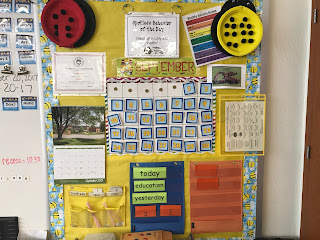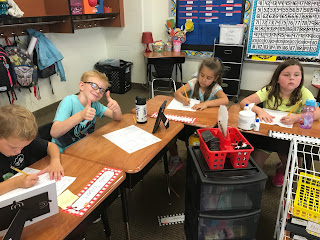Logic is a literacy program that focuses on teaching children the syllable types and the rules that go with each syllable type. To learn more about the Logic program, you can visit: www.logicreading.com The Logic program is supported by the common core standards and is also supported by recent literacy research.
In this blog post, I will explain the different parts of our 40-minute Logic instruction:
Review Skills/New Skills
We start our Logic lesson by reviewing sounds and also introducing a new sound. Each sound is practiced for 2 weeks before being tested on. (Except during the first quarter. The first quarter is a review of kindergarten and we only practice the skills for 1 week before they are tested.)
Above is a picture of the review sounds. I point to the letter e and the children respond by saying: "this is a letter. it's name is e. The sound e makes in a closed syllable word is /e/ /e/ /e/. I also ask the students if the letter is a vowel or a consonant and if it is a voiced or unvoiced letter. We do the same routine for all the the review sounds.
After we review the sounds on the whiteboard, I introduce the new sounds on the smartboard. Above is the picture of the sound y. I tell the children that we are learning the consonant y, y says /y/ /y/ y/ and y is a voiced letter. I also tell the children that the consonant y is found at the beginning of words. We practice some words together on the board.
We also practice our two high-frequency words. We use fridge magnets on the smartboard to help us practice these words.
Auditory Drill
After we review and introduce the new sound, students go back to their seats for the Auditory Drill. I say a sound and students write the letter or letters that say that sound.
Read Words/Sentence
After the Auditory Drill, the students come back down to the carpet to read words and sentences. We break apart the words by their sounds and blend them together. We also discuss the syllable type and any rules that go with the word. For example: The students learned that when a word begins with the /k/ sound, we use a c when there is an a, o, or u and we use a k when there is an i e or y.
Write Words/Sentence
After we read words and sentences, the students go back to their seats and they practice writing words. We finger spell the word first and then write it. I am able to walk around the room and check the students' whiteboards for any mistakes.
We finish the lesson by writing a sentence on our whiteboards.
It is amazing to see these kids in action! They are so smart and they are able to use what they learn from our Logic lesson and apply it to their reading, writing, and spelling.
Next week, I will explain the syllable types that are learned in first grade!



































